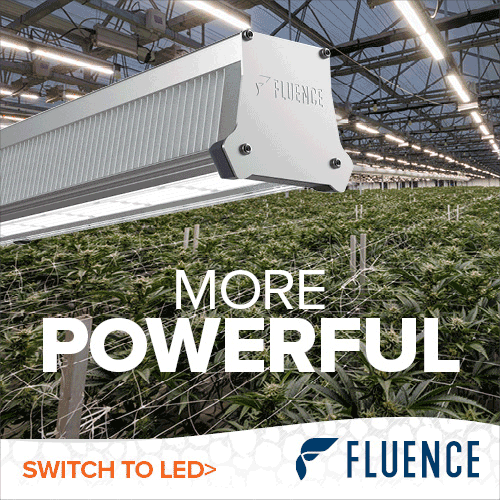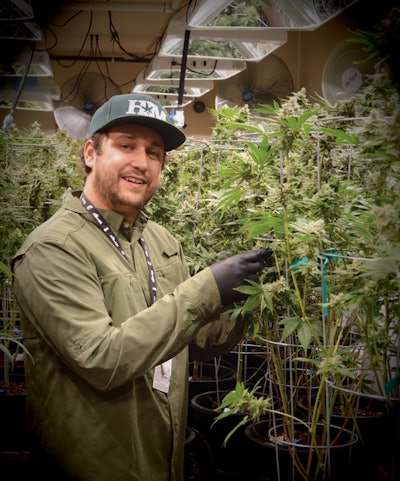
Anthony Franciosi has been an extreme sports athlete his whole life, so it makes sense that he would choose to live in Colorado where he could spend ample time snowboarding. But years of crashes and bails have left Franciosi with multiple broken bones and too many more ankle sprains and rolls to count. The residual pain eventually led him to get his medical marijuana patient card and grow medical cannabis in 2008.
In his professional life, Franciosi worked in landscaping, specifically soil and irrigation systems. He applied his experience in large-scale landscaping to his own cannabis garden.
As the industry grew, he decided he wanted to expand as a professional cultivator, and he met a potential investor through a family connection, who helped him get started. In 2014, he formed Honest Marijuana Company, LLC, built around organic, sustainable practices.
Cannabis Business Times’ Managing Editor Kyle Brown talked with Franciosi about creating a sustainable company, from cultivation, to nutrition, to packaging, including a new recyclable tin can for his product.
Kyle Brown: What do you see as the concept of your company?
Anthony Franciosi: Clean, reliable products from people who care about the plant. A lot of the modern cultivation techniques are set around mineral salts and drip systems. The connection between the gardener and the plant is kind of lost. So my goal is to create clean cannabis and clean marijuana products for people, where they can say, “I know that the [person] who grew this cares about the plant, cares about consumers, and uses it himself and wouldn’t want to put anything harmful in his body.”
That’s what it’s about, consumer trust. I also think the product is better. It tastes better, it tests better, it’s better for you, and we can provide it at a similar price to what some of these big guys are doing.
Brown: What does sustainability mean to you?
Franciosi: For us, it starts with using the most efficient system. We built the building in three floors, so my footprint is only 2,200 square feet with three floors (so 6,600 total). About 5,500 of that is grow, so it’s very efficient and compact. We move plants through a vertical system with a dumbwaiter, so we can move plants from room to room. It allows us total flexibility to really maximize the space.
On top of that, we use more sustainable ingredients. We use plant-based nutrients for our plants, which have less of a carbon footprint than a lot of chemical-based nutrients. All our nutrients are NOP [National Organic Program]-certified. The plastic that the nutrients come in is a recyclable type of plastic, because there are [requirements for growing] you can’t get around.
[Growing can be] naturally wasteful, so we try to look at all the little steps in there and say, “This has to come in plastic, but is there at least good plastic? Can we recycle it? What can we do with it?”
With the influx of cannabis farming that you’re seeing, especially in Colorado, California and those places, cannabis farmers need to be conscientious of the impact they’re having; especially in this boom time. You have people coming into the business and going out of business all the time. When you get in those desperate situations, people are willing to do anything, to spray the pesticides, to do the harmful stuff they know is not good for the water streams, but might make the buds a little bit bigger.
It’s an all-around attitude that I think [we need] in order to make the cannabis industry not another big toxic polluter.
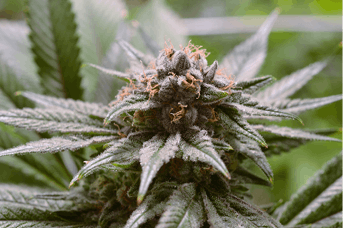
Brown: Tell me about the nutrients you use.
Franciosi: The nutrients we use are made from beets, beet molasses, from kelp, sea kelp and brown kelp. They’re mostly plant-based and can be … regrown. The beet molasses is a beet sugar that we use for a nitrogen source. It comes as a byproduct of beet farming. The companies we use … are all OMRI [Organic Materials Review Institute]-certified.
When I looked at the [nutrient] line, ... it makes sense when you think about what a plant needs and where it comes from. Beets, kelp, there’s a little bit of fish emulsion in it. So you start to look at the nitrogen content and all the things that are in it, and you can feel good about putting it into your product because you know where it comes from.
Brown: What’s your watering method like?
Franciosi: It’s just very simple top-feeding. Organic farming is about a visual connection with the plant. So when we see the plant needs water, … we water from the top down until we notice a little bit of runoff from the bottom of the pot. So it’s very minimal waste coming out.
We water 600 plants with one gallon of water each, so that’s 600 gallons of water. Two percent comes out the bottom of the plant, so that’s 12 gallons. The rest the plant uses, and it transpires through the leaves, which we capture with dehumidifiers, and we collect that in reservoirs.
We either filter it and … use it to water again, or we clean with it, and do any of the other things that we would have to use more water out of the tap for. We feel like it’s a really neat way to save water.
We have a two-step filtration process, so we can use it to water the plants also, if we have extra after all the daily chores.
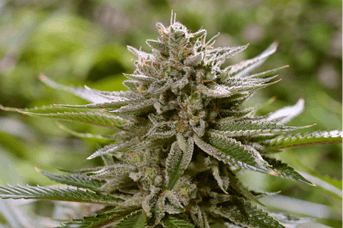
Brown: Let’s talk about your HVAC and power supply systems.
Franciosi: With the HVAC system, we use a water-chilled system, rather than a traditional HVAC. So we have a closed system with air handlers in the rooms and there’s water chillers on the roof. Those chill the water inside the air handler and, as air passes over those cool pipes, it cools.
We have … a dry chiller, which is basically a series of fans that blow air over these miles of copper pipe inside the unit. We use fans to blow the cold air from outside over the cooling system, so that it cools without the need for condensers. Basically it just uses fan power to cool the space, which is extremely, extremely efficient. … It improves our efficiency by 35 percent on the cooling load.
It wouldn’t work in Arizona. You have to have below 40[-degree] ambient temperature outside, which we have a lot of here, so that’s very valuable to us. When the air is below 40, we’re able to blow that air over our cooling system, which allows us to remain a closed system. So we’re not bringing outside air in, but we’re using it rather than a condenser, which takes away a ton of the electrical load.
We get our power from town, like any grow. We just try to use it efficiently, through the cooling system, and then, through the super-efficient lighting. We use 600-watt bulbs rather than the industry standard, and they’re also rated for about 18 months compared to a 6-month light. What a lot of the growers are saying is, “We get better yields with this other light.” But, in my opinion, I get better resin content with the lighting I use, and resin content is what we’re after. We’re farming trichomes, we want the little trichome heads in the most abundance, not necessarily the biggest, heaviest flower.
Brown: Tell me about the packaging tin you’re using.
Franciosi: We work with a company called N2 Packaging Systems. Basically, it’s their concept and their idea. I’ve worked seven days and 70 hours a week to make the highest-quality [flower] possible. We use the best ingredients in the system. I can’t be selling it in a plastic bag. I just can’t. I needed to get it to my customer in the same condition as it left here.
A friend of mine came through from Oregon with one of those cans when it was in the early stages of testing, and I said, “Wow.”
I called my partner, and we got a hold of the people who make them.
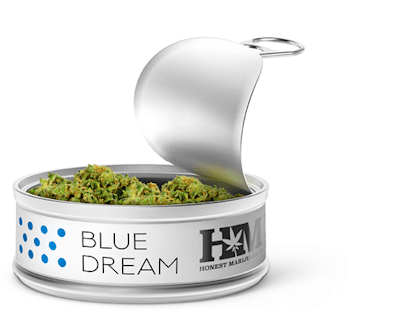
Our goal was, “How are we going to deliver this to the customer in the most environmentally friendly way with the ultimate experience?” We love the eco-friendliness of it. We love everything about it.
The tin is the most commonly recycled and the easiest material on the earth to recycle. It takes a lot of energy to produce the plastics you see in dispensaries now, and they’re petroleum-based. They’re not as easy to recycle. They’re bulkier, too. This way, we’re going to be able to streamline that kind of out-the-door system with these cans, so there’s less plastic involved.
There’s a number of different sizes you can get. Right now we’re offering it in the one-eighth size. I hate to compare it to a tobacco product, but the best comparison I have is a chew-can size.
So an eighth fits in there very nicely. If I’m going to buy an ounce, I would prefer it in eight cans, because I’m not going to use it all at once. This way, I can open them as I see fit for my consumption, and that will allow me to maintain the freshness of the whole batch. … It’s all still recyclable, so the guilt of all those containers can be washed away a little bit.
In its tin, it will preserve itself up to a year, that’s what we’re saying professionally. The nitrogen inside is actually more dense than oxygen, so if you were to open it and leave it purposefully flat, in theory, the nitrogen would still be in there, and you could reseal it, and it would probably hold better. But the idea … is that it’s only preserved solely until the point when you pop it open, and at that point, you’ll have a lid you can put on top.
The rest [of the water] the plant uses, and it transpires through the leaves, which we capture with dehumidifiers, and we collect that in reservoirs.”
Brown: How did you sell your partner on this?
Franciosi: Passion, I think. I’m a passionate person. But it comes down to numbers, too. You have to be able to provide the same outcome as other systems. … I was insistent that organic was the only way, and that a mix of the world of commercial cannabis where square footage of the grow is skyrocketing, the amount of cannabis on the market is skyrocketing, the only way to be viable in a small footprint is to provide the highest-quality to the customer. And that jives financially and jives with me morally.
I think I was able to create the whirlwind of the really good concept that is based in reality. We’re not doing this purely for philanthropic reasons. I tried to match the passion and the concept with the moral high ground and the profitability.
Brown: How do you try to make that stand out in your marketing when you can’t use the word “organic”?
Franciosi: In all our marketing, we try to … educate [people] that there is a difference between organic and non-organic, and there’s a difference between best practices and not best practices. We just try to keep the message consistent as far as: We use the highest-quality ingredients, and we have the best intentions behind why we’re doing it. If you’re using this as a holistic homeopathy, whether you’re using it recreationally or medicinally, the idea is that it’s better for you.
Brown: What kind of data do you collect?
Franciosi: The data we collect is tied to how much we spend to produce. Besides that, we collect data on every watering. We collect how much it takes to operate one light for one day, and how much it costs to have a room running for a day.
When the plant goes into the room, it starts to accumulate a cost history based on how many lights are in that room. We also track the cost of our ingredients, so you can see the plant through the course of its life, how much was spent on the plant, how much was spent on the electricity, how much it costs to maintain the fixtures and the employees. Then you obviously collect how much it costs to trim, and there’s the packaging.
We track … [e]very ingredient that goes into every plant, how long a plant stays in a room, how much it costs to [operate] the lights in that room for a day, and then it all kind of sums up to a formula in how much it costs per gram.
Brown: If a cultivator wants to be more sustainable, where’s a good place to start?
Franciosi: I think a big place to start is the overuse of nutrients, especially high NPK [nitrogen-phosphorus-potassium] nutrients and ones that have chemical chelators in them that can be potentially harmful to the water system.
The next thing you can look at is lighting. … Especially for indoor growers, using alternative lighting that has less electrical needs. Eventually, you can dial it in correctly and improve your bottom line by lowering your expense, maybe lowering your cooling loads, too. You might see a lower yield or maybe not, but you’ll improve your grams per watt ratio.

